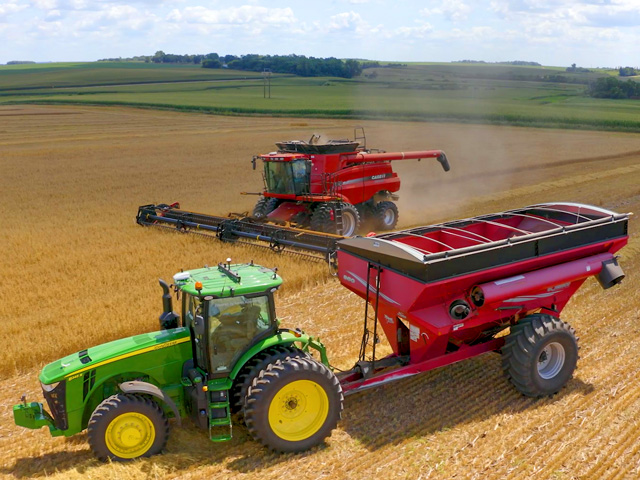Raven's Next Step to Autonomous Farming
OMNi Brand Signals Raven Industries Newest Autonomous Push
Raven Industries, of Sioux Falls, South Dakota, has been making big moves in the autonomous farming arena. It recently purchased the intellectual property and patents of Jaybridge Robotics. Its portfolio included patents for path-planning, obstacle detection and avoidance, and multi-machine control.
On Wednesday, Raven announced the launch of an autonomous growth platform, OMNi. The OMNi brand spotlights and organizes both Raven's developmental direction and its advancements in autonomous solutions.
"OMNi solutions provide multiple paths to autonomy and equip the ag professional to get more, do more, and give more from their operation," Raven said in a press release. Effective Wednesday, OMNiDRIVE replaces the 'AutoCart' name from the previous acquisition of Smart Ag. The former 'DOT' name is now OMNiPOWER.
OMNiDRIVE is Raven's aftermarket technology kit that converts existing tractors into driverless machines during harvest. The application allows operators to monitor and operate a driverless tractor from the cab of the harvester -- the tractor, with cart, directed to a predetermined unloading area -- without a second driver.
The system is currently compatible with John Deere 8Rs Powershift and IVT (2010 to current models). By October 2021, the system will offer compatibility with Case IH Magnum CVT, 2014-2020 models, M250/280/310/340/380 and New Holland CVT, 2014-2020 models, T8.320/350/380/410/ 435.
OMNiPOWER is a self-propelled platform currently offering interchangeable implements for spreading and spraying. Raven said additional applications are about to be launched.
DTN/Progressive Farmer did the following Q&A with Raven's Director of Strategic Initiatives Dominic Walkes to catch up with these, and other topics:
**
DTN/PF: Tell us about the OMNi brand launch (Wednesday).
Walkes: Raven is on a journey to bring higher levels of autonomy into the agricultural space. We have had some acquisitions, DOT, SmartAg, Jaybridge. It is exciting to launch a branding campaign that brings all those components together under the OMNi brand.
DTN/PF: What does the Jaybridge package bring to Raven product development?
Walkes: Jaybridge had a nice portfolio that we see as giving us flexibility for future functionalities and capabilities. In general, their ability to path plan, or coordinate with multiple machines, are some things that we are keenly interested in.
P[L1] D[0x0] M[300x250] OOP[F] ADUNIT[] T[]
DTN/PF: Would you explain Raven's general philosophy toward automation?
Walkes: In general, we want to help farmers do more with less, to optimize, to be more efficient. As we see opportunities for us to take the technologies we have today, or (develop the) competencies and apply them in new ways, that's what gets us excited.
DTN/PF: Explain Raven Industries' work direction toward greater levels of autonomy.
Walkes: Our focus is on bringing higher levels of machine automation and autonomy into the ag space. GPS-guided solutions have been in the marketplace for some time. We will continue to build off that by using advancements in technology and in communications.
DTN/PF: What's driving autonomy research at Raven?
Walkes: It feels like labor is, this year. There are labor challenges on the heels of COVID, having a flexible workforce. That is really changing the dynamics, the level of interest we are seeing. We continue to see opportunities to drive efficiency in operations. We're just scratching the surface to see what's possible to optimizing the entire farm.
DTN/PF: In the nearer term, how does Raven operate in the autonomous farming landscape?
Walkes: We see it happening in progression, building to a point where the person in the field today, can be remote or remote for a portion of the mission. That's on the near-term horizon. Traversing down roads and things like that is not a focus of ours today. We are trying to solve the in-field (challenges) first.
DTN/PF: When does that day of full autonomy come?
Walkes: To get to that holy grail where the machine drives itself out of the shed, goes to a field, executes a mission, and then comes back when it's done, over-the-road transport is still a big one that we see in the farther horizon. It's possible, but not something we are seeing solved in the next two to three years.
DTN/PF: Explain the impact of remote digital communication limitations on Raven's drive to full autonomy.
Walkes: We look at communications as 'in the field' and 'beyond the field.' We've had nice advancements in both. I believe in-the-field communications are more mature. With the availability of broadband, I have optimism for continued growth to enable new and advanced capabilities.
DTN/PF: What is lacking, technology holes that inhibit the ability of machines to communicate with one another, or with distant managers?
Walkes: Speed and coverage. I'd says coverage is more challenging than speed.
DTN/PF: Would you explain?
Walkes: In my opinion there is a misperception that 5G might solve this. To me, it could really be the proliferation of 3G and 4G into remote and rural areas, or an alternative to cellular communications that provides a better blanket for those acres.
DTN/PF: Is 5G not reliable in rural areas, or is it too expensive?
Walkes: It doesn't seem financially viable in remote areas. We're talking about areas that never got 3G, never got 4G. I don't see why those areas would get 5G, or why that would happen on a faster pace. Maybe I'm too pessimistic. But that's my opinion.
DTN/PF: What alternatives are there to cellular communications?
Walkes: Satellite-based solutions have been around for a long time. We're seeing nice activity in that space with Starlink and others trying to drive this into more mainstream communications. But we still have a way to go for that to be truly viable.
(Starlink is a satellite internet constellation built by SpaceX to provide satellite internet access. The constellation will consist of thousands of mass-produced small satellites in low Earth orbit.)
For more information: https://ravenprecision.com/…
Dan Miller can be reached at dan.miller@dtn.com
Follow him on Twitter @DMillerPF
(c) Copyright 2021 DTN, LLC. All rights reserved.




